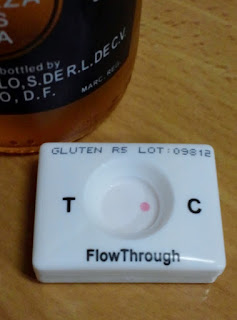
 I'm pretty much a beer-only guy when it comes to drinking, so going gluten-free presented a challenge. However, when I noticed Kirin's Hard Cidre (キリン ハードシードル) on the shelves at a local supermarket, I felt a slight sense of relief. I've never been much into ciders, but I figured I'd give it a go. Judging from the ingredients listed on the label, I was pretty sure this stuff would test negative, but I thought I might as well check for cross-contamination or something like that.
I'm pretty much a beer-only guy when it comes to drinking, so going gluten-free presented a challenge. However, when I noticed Kirin's Hard Cidre (キリン ハードシードル) on the shelves at a local supermarket, I felt a slight sense of relief. I've never been much into ciders, but I figured I'd give it a go. Judging from the ingredients listed on the label, I was pretty sure this stuff would test negative, but I thought I might as well check for cross-contamination or something like that.Well, to make a long story short, my test didn't detect any gluten whatsoever. Hooray! As far as the taste goes... again, I've never been much into ciders, so I can't really compare it to anything else. Kirin says it's a dry cider, and I'd have to agree with that. The first one goes down pretty easily, but halfway into the second one, my mouth starts doing a tspt tspt kind of thing. Not sour per se, just tart.
 So from there, I decided to mix it 50/50 with Asahi Dry Zero non-alcohol "beer" (see my post here), and I was rather satisfied with the results. A 50/50 mix of lager and cider is called a snakebite, so I'm going to call this a fakebite. Seems like a nice summer drink. The Hard Cidre has an alcohol content of 4.5% ABV (alcohol by volume), so mix that with the Dry Zero and you've got a pretty light drink, good for a barbecue or the beach!
So from there, I decided to mix it 50/50 with Asahi Dry Zero non-alcohol "beer" (see my post here), and I was rather satisfied with the results. A 50/50 mix of lager and cider is called a snakebite, so I'm going to call this a fakebite. Seems like a nice summer drink. The Hard Cidre has an alcohol content of 4.5% ABV (alcohol by volume), so mix that with the Dry Zero and you've got a pretty light drink, good for a barbecue or the beach!A 290ml (9.8 fluid ounces US) bottle of Hard Cidre runs less than ¥200. Let's hope Kirin doesn't pull it off the market anytime soon.














